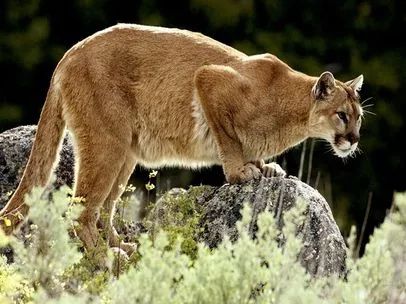What to do if you encounter a mountain lion
The mountain lion, also known as cougar or puma (Puma concolor), is the fourth largest wild cat in the world, surpassed only by the tiger, lion, and jaguar.
Source of this article: The Winter 2023 Newsletter from the Ojai Valley Land Conservancy
 These magnificent animals can run at speeds of up to 50 miles per hour and jump up to 18 feet in a single bound, making them one of the fastest and most agile land animals in North America. In the Ojai Valley, they are a keystone species, playing a critical role in regulating prey populations and shaping the landscape.
These magnificent animals can run at speeds of up to 50 miles per hour and jump up to 18 feet in a single bound, making them one of the fastest and most agile land animals in North America. In the Ojai Valley, they are a keystone species, playing a critical role in regulating prey populations and shaping the landscape.
Although mountain lions have a fearsome reputation, they typically avoid confrontations with humans, and attacks on humans are rare. In fact, you are more likely to be struck by lightning than attacked by a mountain lion. They are carnivorous and primarily feed on deer, but they have been known to prey on smaller animals such as rabbits, rodents, and pets—as recent events in the valley have shown.
As human and mountain lion interaction increases in the valley, we provide the following tips to prepare you in the unlikely event that you come face-to-face with these felines:
• When walking or hiking in mountain lion territory, it’s best to travel in groups and make plenty of noise to avoid startling a lion.
• Keep children close and in your sight at all times. Keep your dog on a leash.
• Avoid approaching a lion, especially one that is feeding or has kittens. Most lions will avoid confrontation, so give them an escape route.
• If you come upon a lion, stay calm and talk calmly but firmly to it. Back away slowly if you can do so safely. Running may provoke a lion’s instinct to chase and attack, so face the lion and stand upright.
• Try to appear larger by raising your arms or opening your jacket if you have one. If you have small children with you, protect them by picking them up so they won’t panic and run away. Wave your arms slowly and speak firmly to convince the lion that you are not prey and may be a threat to it.
• Make noise by carrying an air horn or other loud device to startle and scare off the lion.
• If the lion behaves aggressively, throw stones, branches, or any objects you can find without crouching or turning your back. Do not throw anything at the lion’s head as this can injure it and make the situation worse.
• If the lion attacks you, fight back with whatever you have at your disposal. A sturdy walking stick is also useful for fending off a lion. People have successfully fought back with rocks, sticks, jackets, and even bare hands. Remain standing or try to get back up if possible.
When using an OVLC preserve, keep in mind that you are hiking in the mountain lion’s home, and these cats are an essential keystone species in our local ecosystem. Mountain lions are known to roam in urban areas, particularly near the wildland-urban interface, where human development meets undeveloped wildland. We must remember that we share our environment with these animals, and this is why we experience mountain lion activity in town. Habitat loss and fragmentation due to development, as well as weather patterns indicative of climate change, likely contribute to the increase in activity.
To learn more about mountain lions, visit: ovlc.org/ojai-wildlife/cougar



0 Comments